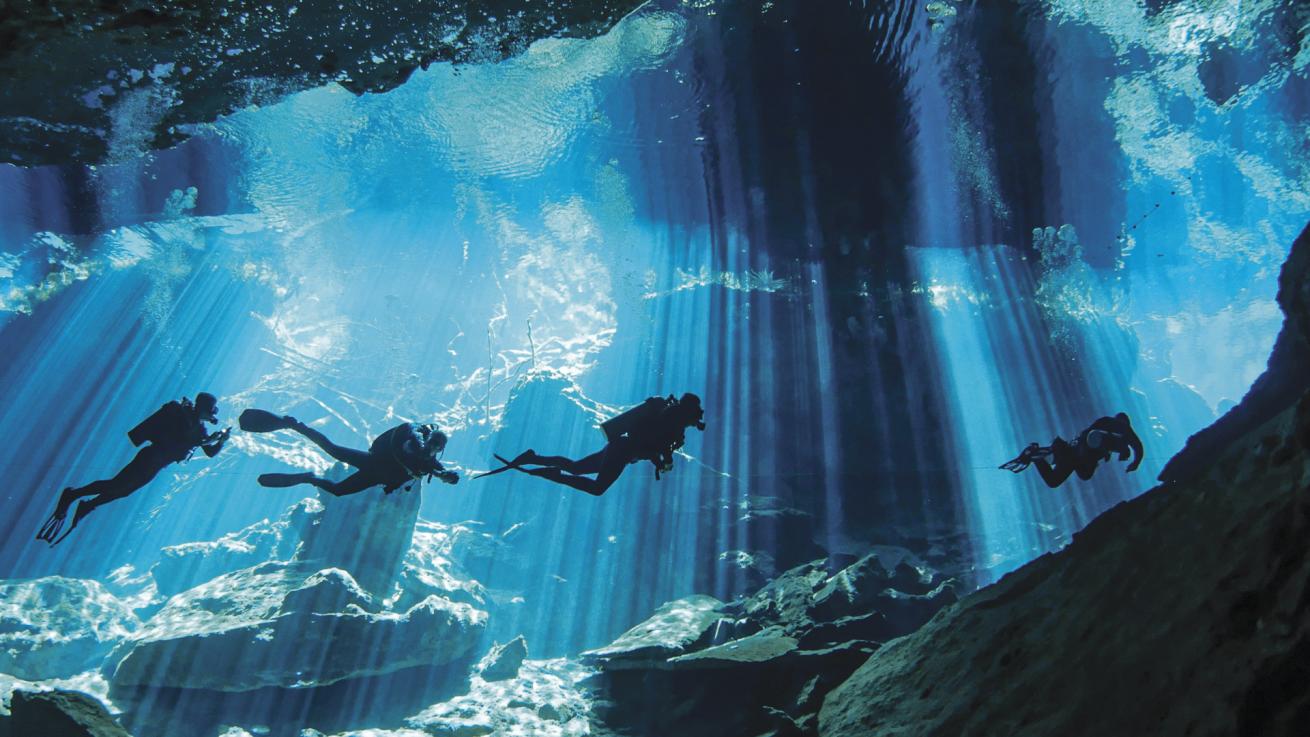What It's Like to Be a Cavern Guide in Mexico

Shutterstock / Timophey AkulichCenote guides must be cave certified in order to lead tours.
Rigo Amador starts his workday by loading dive gear and tanks into his truck and making the rounds to pick up clients from their hotels in Mexico’s Riviera Maya region before slipping beneath the surface of some of the world’s most beautiful and unique underwater landscapes.
As the owner and sole operator of Rigo the Cenote Guide, Amador exclusively offers guided dives into Quintana Roo’s vast network of underwater caves and caverns, known as cenotes.
Cenotes are natural sinkholes found in the Yucatan Peninsula. Most contain fresh water, but some have a layer of salt water as you descend. The Mayan word dz’onte translates to “cavern with water,” and the Maya consider cenotes to be sacred portals to the underworld. They often have crystal-clear visibility, where divers can explore flooded tunnels and cavern formations, with some areas illuminated by beams of sunlight shining through openings in the jungle floor.
Amador’s journey started in California, where he was scuba certified. “I immediately fell in love with diving,” he says. “I became obsessed with it and signed up for course after course until I had done my divemaster.”
During the pandemic, Amador was looking for a change. With dual U.S. and Mexican citizenship, he moved to Playa del Carmen, where he got his first taste of cavern diving at Cenote Eden. “I immediately knew this is what I want to do as a career,” he says. “But to work as a cenote guide here, you have to be a certified cave diver with at least a divemaster certification, six months minimum experience and a letter of endorsement from a cave instructor.”
Related Reading: Discovering the Wonders of Mexico's Cenotes for the First Time
Amador spent 10 days completing his sidemount, cavern, intro to cave and full cave diver courses, then went to work building his business. He has no storefront, which keeps overhead low. He primarily books customers through his website and social media, and he maintains the supply of gear and tanks he needs to take up to four divers per day on private tours of cenotes throughout the region.
Three types of cenotes are found in the Yucatan: open and semi-open caverns, and caves. Cave cenotes generally have a single entry and exit, and require a cave-diver certification. Guides like Amador lead tours of sites where entry and exit points are accessible throughout the dive.
Amador takes pride in introducing people to the cenotes. “It’s like going back in time as you’re gliding past these huge columns, remembering that stalactites take a thousand years to grow just 10 centimeters,” he says. “Along with the beauty of the cenotes themselves, there are also spots like Cenote El Pit where we can see artifacts like ancient Mayan pottery and bones.”
Related Reading: Tourist Train Endangers Mexican Cenotes and Prehistoric Sites
Safety and personalized attention are crucial in the tight confines of a cavern, so Amador keeps a close watch on his divers, especially those who are nervous or less experienced. All cavern dives follow a permanent guide line and are planned using the rule of thirds: one-third of your tank for going into the cavern, one-third for coming back and one-third in reserve for emergencies.
“Each diver receives a cavern-diving briefing before entering the water, which includes specific dive procedures, including how to communicate with a flashlight. The caverns have multiple exits, so if a diver has an issue, I can take them up to the nearest exit,” he says. “The nice thing about doing these personalized, small-group dives is that I can cater to any needs or abilities the divers have—I just want to show people this world, and it’s totally worth it to watch clients absolutely fall in love with these places.”
Job Requirements
Degree: None
Salary: $50,000 to $65,000 per year
Certifications: Full cave diver, divemaster, along with CPR, first aid and oxygen provider.










